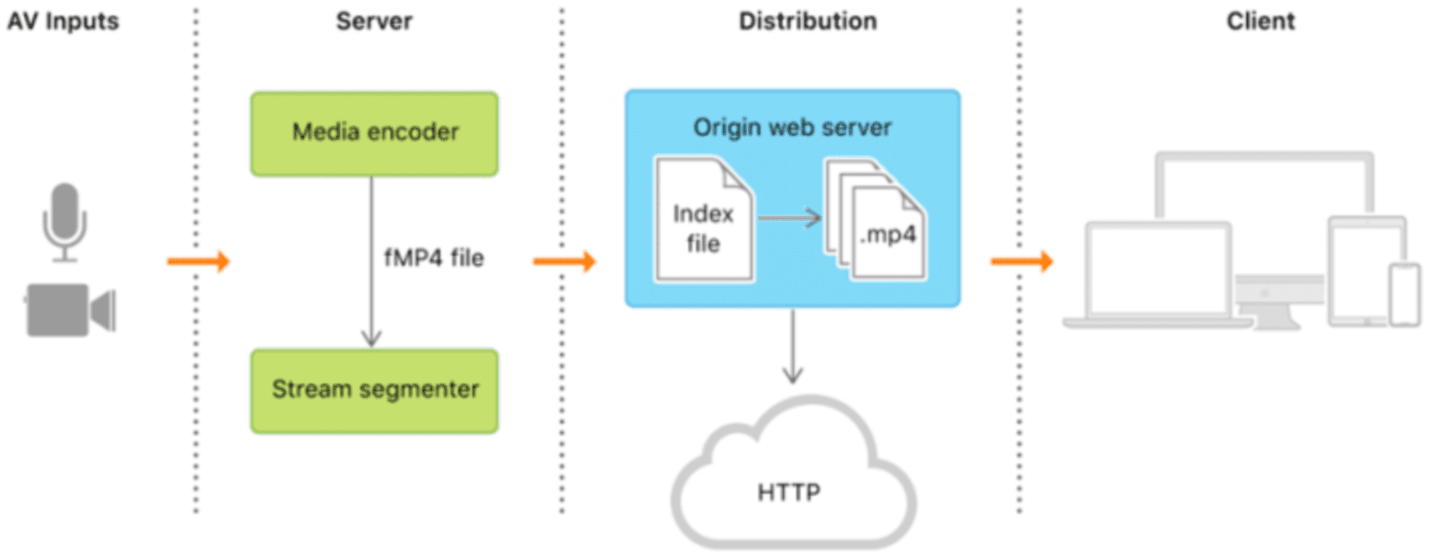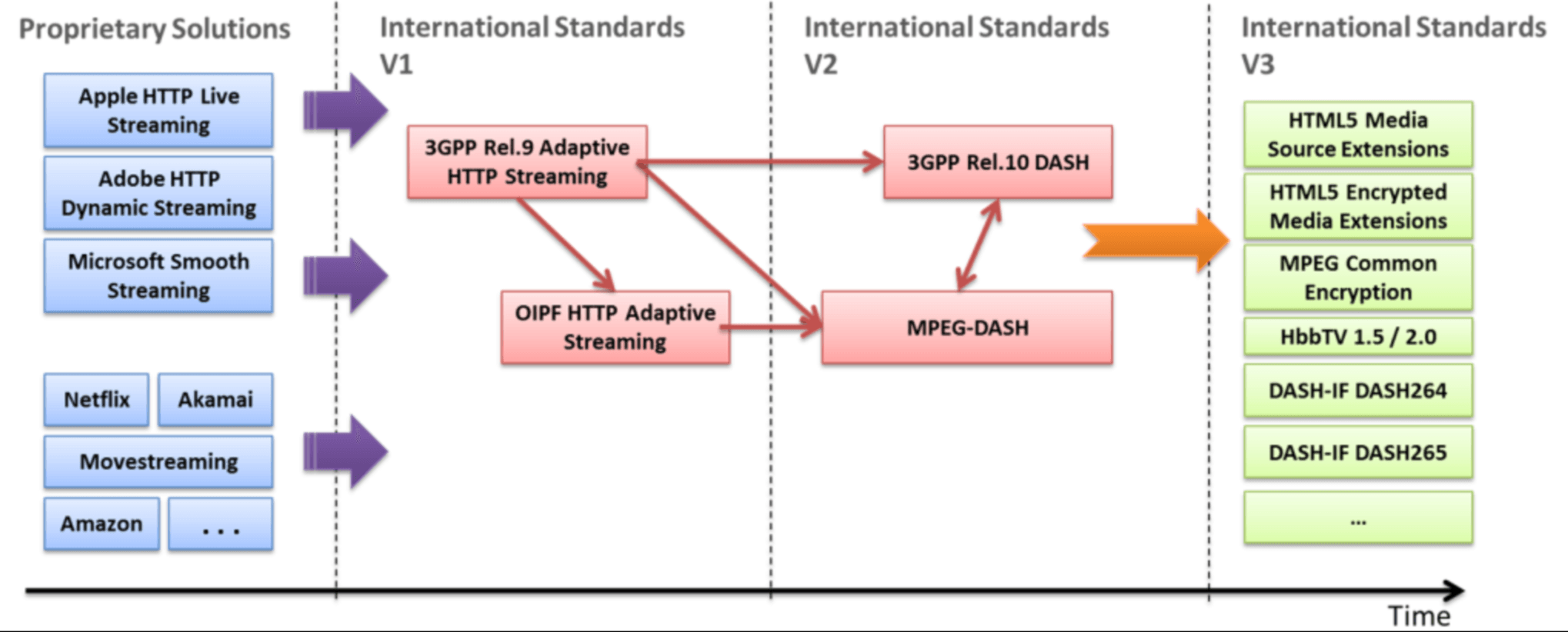HLS vs DASH: Analyzing the Key Differences in Streaming Technologies
In today's digital media era, streaming media has become a primary means of obtaining entertainment, education, and information. Whether it's online education, enterprise live streaming, or entertainment video playback, robust technical support is always present behind the scenes. Adaptive Streaming Technologies are a crucial part of this ecosystem, and among the various streaming protocols, HLS (HTTP Live Streaming) and DASH (Dynamic Adaptive Streaming over HTTP) are undoubtedly the most widely used.
HLS was introduced by Apple and has dominated the video streaming market on iOS devices and many other platforms since its inception. It is based on HTTP and can automatically adjust the bitrate in different network environments to ensure smooth and clear video playback. DASH, on the other hand, is a standard proposed by the MPEG organization, aimed at providing broader device compatibility and more flexible streaming solutions. Using similar methods, DASH can also adapt to different network conditions to optimize the video playback experience.
Understanding and comparing these two protocols is particularly important for those involved in streaming media development, operations, and maintenance. This article will delve into the technical details, performance, application scenarios, and future trends of both HLS and DASH, helping you make the best choices in your projects.
What is HLS?
HLS, short for HTTP Live Streaming, is a streaming protocol based on HTTP that was introduced by Apple in 2009. HLS aims to address the issues of playback interruption and quality degradation that arise from varying network conditions in traditional streaming methods. It works by dividing the video content into small MPEG-TS file segments, which are then transmitted and played back segment by segment through the HTTP protocol.
Key Features
- Adaptive Bitrate Streaming: HLS can automatically select different bitrate versions based on network conditions, ensuring users get a smooth viewing experience under varying network conditions.
- Wide Device Support: HLS is widely adopted within the Apple ecosystem, with almost all iOS and macOS devices natively supporting HLS. This makes it the preferred streaming protocol on Apple devices.
- Simple Implementation: The HTTP-based transmission method makes HLS very easy to deploy, especially for teams already familiar with web development technologies, making implementation relatively straightforward.

What is DASH?
DASH, short for Dynamic Adaptive Streaming over HTTP, is an adaptive streaming standard released by MPEG (Moving Picture Experts Group) in 2011. Similar to HLS, DASH uses HTTP-based transmission, but it is designed with broader compatibility and greater flexibility in mind.
Key Features
- International Standard: As an international standard, DASH is widely supported by numerous devices and platforms, including Android. It also enjoys recognition and support from many browsers and media players.
- Flexible Codec Support: DASH supports various audio and video codecs, making it highly adaptable to different application scenarios.
- Separate Media Segmentation: DASH uses separate media description files and segment files, a structure that offers greater flexibility in content protection, ad insertion, and other aspects.

Technical Comparison: HLS vs DASH
Adaptive Bitrate Streaming
Adaptive Bitrate Streaming is a core feature shared by both HLS and DASH. This technology involves encoding the video content into multiple versions with different bitrates and dynamically switching the bitrate based on the user's current network conditions to ensure smooth playback and good video quality. Although their adaptive processes are fundamentally the same, there are some differences in the implementation details:
- HLS: Uses M3U8 playlist files to describe the available bitrate versions and corresponding TS segments. During playback, the player selects appropriate segments based on the bandwidth conditions.
- DASH: Uses Media Presentation Description (MPD) files to describe information about the streaming content, including available bitrates, segment URLs, and more. DASH's MPD files are more flexible and rich, allowing application in a wider range of scenarios.
Segmented Files
Segmentation is crucial for implementing adaptive bitrate streaming in both HLS and DASH. By dividing the video into smaller chunks, the player can quickly switch segments when network conditions change, avoiding playback interruptions.
- HLS: Defaults to using MPEG-TS format for segment files, suitable for cross-platform transmission. However, TS format segments are structurally more complex, which increases segment overhead.
- DASH: Supports various segment formats, such as the ISO Base Media File Format (CMAF), providing greater flexibility and compatibility. DASH also supports more efficient MP4 segment formats, which helps reduce latency and shorten load times.
Codec Support
Both HLS and DASH support multiple audio and video codecs, but their default supports differ:
- HLS: Primarily supports H.264 video codecs and AAC audio codecs, and has started supporting H.265 and HEVC codecs, making it perform excellently within the Apple ecosystem.
- DASH: Supports a broader range of codecs, including H.264, H.265, VP9, and AV1. DASH's multi-codec support makes it more flexible in cross-platform and multi-device environments.
Communication Protocols
Both HLS and DASH are transmitted via HTTP, but they differ in the support for more advanced communication protocols:
- HLS: Mainly uses HTTP/1.1 for transmission, but the newer versions have started supporting HTTP/2, improving transmission efficiency and concurrency.
- DASH: Natively supports HTTP/2 and QUIC protocols, offering higher transmission efficiency and lower latency, particularly in high-concurrency and complex network environments.
Latency and Buffering
Latency and buffering are key performance metrics in streaming protocols. HLS and DASH each have their strengths in these aspects:
- HLS: Because it uses MPEG-TS segments and relatively long segment lengths (typically 6 seconds), it results in higher overall latency, making it less suitable for real-time streaming scenarios.
- DASH: By adopting shorter segment lengths (as short as 2 seconds or less) and supporting more efficient segmentation formats, DASH performs better in low-latency and real-time streaming scenarios.
Performance Analysis: HLS vs DASH
Throughput
HLS: Due to its use of long segments (typically 6 seconds), HLS can effectively transmit high-quality video content in high-bandwidth network environments. However, long segments may also lead to resource wastage and additional retransmission overhead during network fluctuations.
DASH: Supports shorter segment lengths (as short as 2 seconds or less) and can flexibly adjust segment sizes based on network conditions, allowing it to maintain efficient throughput in various network environments.
Latency
HLS: Longer segment lengths result in higher latency for HLS in live streaming, making it unsuitable for scenarios requiring high real-time performance, such as sports broadcasting and real-time interactive video.
DASH: Shorter segments and more efficient file formats enable DASH to have better control over latency, making it highly suitable for real-time streaming applications that demand low latency.
Buffering Strategies
HLS: Long segments mean that the player must download an entire segment before playback, which can lead to frequent buffering and playback stuttering under poor network conditions.
DASH: Short segments and flexible transmission strategies allow DASH to start playback quickly in any network condition and dynamically adjust during network fluctuations, reducing buffering time and playback interruptions.
Playback Stability
HLS: Relies on longer buffer periods to smooth out playback, but during network instability, long-duration retransmissions may cause playback hiccups.
DASH: Through short segments and adaptive bitrate strategies, DASH balances playback quality and stability, offering a smoother viewing experience.
Bandwidth Utilization
Bandwidth utilization determines the efficiency of streaming media transmission under varying network conditions.
HLS: Longer segments mean higher initial overhead and burst bandwidth demands, potentially leading to bandwidth wastage, especially during network changes.
DASH: Short segments and efficient bitrate switching mechanisms allow DASH to dynamically adjust bandwidth requirements based on real-time network conditions, maximizing bandwidth utilization and minimizing wastage.
Application Scenarios
Live Streaming
HLS: Due to the long segments (typically 6 seconds), HLS can cause high latency in live streaming, making it less suitable for scenarios requiring high real-time performance. However, Apple's introduction of Low-Latency HLS (LL-HLS) has partially mitigated this issue, making HLS applicable even in some scenarios previously hindered by high latency.
Advantages: Broad support on Apple devices, suitable for high-resolution and high-stability live streaming scenarios.
Disadvantages: Longer latency, providing a suboptimal experience for interactive live streaming scenarios.
DASH: DASH can use shorter segments (as short as 2 seconds or less), providing lower latency for real-time live streaming. Additionally, DASH can leverage low-latency transmission protocols like HTTP/2 and QUIC to further reduce latency.
Advantages: Suitable for low-latency, high-interactivity live streaming scenarios with strong cross-platform support.
Disadvantages: Native support on Apple devices is lacking, requiring additional player software.
Video on Demand (VOD)
HLS: HLS performs excellently in VOD content, especially on Apple devices, providing high-quality video playback. Through adaptive bitrate streaming, it can maintain smooth playback even under unstable network conditions.
Advantages: Simple implementation, native support on Apple devices, high-quality playback.
Disadvantages: Less cross-platform compatibility compared to DASH.
DASH: DASH also excels in VOD transmission, supporting various codecs and playback formats, ensuring stable operation across different devices and network conditions.
Advantages: Flexible codec support, strong cross-platform compatibility.
Disadvantages: Slightly more complex implementation compared to HLS.
Ad Insertion
HLS: HLS can insert ads between segments for seamless playback. However, the longer segment length limits its flexibility in ad insertion.
Advantages: Simple ad insertion method, suitable for static and simple ad scenarios.
Disadvantages: Limited flexibility in ad insertion, not suitable for complex ad requirements.
DASH: DASH offers higher flexibility in ad insertion, allowing seamless insertion of ads within shorter segments. Additionally, it supports customizable ad playback strategies to meet complex ad requirements.
Advantages: High flexibility, supports various ad insertion methods, suitable for complex ad scenarios.
Disadvantages: More complex implementation, requiring higher technical support.
Interactive Features
HLS: HLS is limited in terms of interactive features, mainly due to its longer segments and higher latency.
Advantages: Suitable for basic interactive scenarios, relies on the Apple ecosystem.
Disadvantages: Insufficient support for highly interactive and real-time scenarios.
DASH: DASH excels in supporting interactive features, owing to its low latency and high flexibility, making it suitable for highly interactive live video streaming and experiences.
Advantages: Supports highly interactive and low-latency scenarios, suitable for specific industry interactive needs.
Disadvantages: Requires more technical resources to implement.
Different Market Needs
Enterprise Live Streaming
For enterprises primarily using Apple devices, HLS offers a stable and high-quality live streaming solution that simplifies technical implementation. Examples include corporate meetings and training live streams, especially in scenarios predominantly involving Apple devices.
DASH is better suited for enterprise environments that involve diverse device usage and require cross-platform support. Examples include large-scale enterprise meetings, cross-departmental training, and scenarios that need to support multiple terminal devices.
Cloud Live Streaming
HLS excels in cloud live streaming scenarios where high quality and reliability are paramount, particularly on Apple devices. Examples include cloud video conferencing and educational live streams, which focus heavily on user experience.
DASH’s strengths in resource scheduling, handling high concurrency, and cross-platform support make it highly suitable for cloud streaming. Examples encompass large online events, international conference streaming, and scenarios requiring support for multiple devices and high interactivity.
Real-World Examples
Platforms Using HLS: Apple TV, iTunes, YouTube (some content). These platforms use HLS to provide high-quality video content, especially excelling on Apple devices.
Platforms Using DASH: Netflix, YouTube (major content), Amazon Prime Video. By using DASH, these platforms can offer video services with cross-platform support, ensuring efficient streaming and low-latency experiences.
Future Developments and Trends
Low-Latency Optimization
Continuous Improvement of LL-HLS and LL-DASH: To meet the growing demands of low-latency scenarios, LL-HLS (Low-Latency HLS) and LL-DASH (Low-Latency DASH) will continue to be optimized and popularized. Future developments will focus on optimizing segment lengths, increasing edge caching support, and improving low-latency algorithms in players.
Application Examples: The use of low-latency streaming protocols will become increasingly common in scenarios with high real-time requirements, such as sports live broadcasts, esports live streams, and online classrooms.
Evolution of Codecs
Promotion of Next-Generation Codecs: As the demand for video quality increases and bandwidth resources become limited, the use of next-generation codecs (such as AV1, HEVC, VP9, etc.) will become more widespread. These codecs can provide higher video quality with the same bandwidth or significantly reduce bandwidth consumption while maintaining current quality.
Real-Time Encoding Technology: The development of real-time encoding and transcoding technology makes the adaptation and transmission of streaming content more flexible, better meeting users' real-time needs.
Content Protection and Digital Rights Management (DRM)
Strengthening Content Protection: As the value of digital media content increases, the importance of content protection and copyright management becomes more prominent. HLS and DASH will further optimize support for DRM technologies (such as Widevine and FairPlay) to ensure the secure distribution and consumption of content.
Multi-Platform Compatibility: Future developments will focus on simplifying the cross-platform application of DRM, enabling developers to more easily integrate content protection solutions across different platforms and devices.
Application of Artificial Intelligence and Machine Learning Technologies
Intelligent Optimization of Streaming Transmission: Leveraging Artificial Intelligence (AI) and Machine Learning (ML) technologies can more intelligently optimize streaming transmissions. For example, by predicting user behavior to adjust bitrate, dynamically adjusting caching strategies, and real-time detecting and repairing transmission anomalies.
Enhancing User Experience: The application of AI and ML technologies not only improves transmission efficiency but also significantly enhances user experience through intelligent recommendation systems and personalized content delivery.
Conclusion
As mainstream streaming protocols, HLS and DASH each have their own advantages and applicable scenarios. HLS, with its seamless integration on Apple devices and ease of implementation, is suitable for applications requiring medium-to-high latency but high stability, such as enterprise live streaming and video-on-demand. Conversely, DASH, with its extensive cross-platform compatibility, low latency, and high flexibility, meets the needs of real-time live streaming and highly interactive scenarios.
When choosing a streaming protocol, it is essential to consider the target user devices, specific application scenarios, and the technical implementation and resource investment. In the future, with the integration of emerging technologies and continuous optimization, HLS and DASH will continue to leverage their respective advantages in different fields. Ultimately, understanding and appropriately applying these protocols will help deliver the best user experience and business outcomes.Thank you for reading, and if you have any questions or topics you'd like to discuss in-depth, please feel free to Contact Us at any time.
